Volkswagen Karmann Ghia
The Volkswagen Karmann Ghia are a family of three overlapping sporty Volkswagen model series, marketed in 2+2 coupe (1955–1975) and 2+2 convertible (1957–1975) body styles, though German production ended one year before that in Brazil. Internally designated the Type 14 (1955–1975), the Type 34 (1962–1969), and the Type 145 TC (1972–1975; Brazil), the Karmann Ghia cars combined the floorpans and mechanicals of the Type 1 / Beetle or Type 3 'ponton' models with styling by Italy's Carrozzeria Ghia, and hand-built bodywork by German coachbuilding house Karmann.[4]
| Volkswagen Types 14, 34, and 145 | |
|---|---|
.jpg.webp) 1962 Type 14 VW Karmann Ghia | |
| Overview | |
| Manufacturer | Volkswagen |
| Production | Germany Type 14: 1955–1974 Type 34: 1961/1962–1969 445,238 total units built: [1] Brazil Coupé: 23,393 Cabriolet: 177 TC (Touring Coupé): 18,119 |
| Assembly | West Germany: Osnabrück[3] Brazil: São Bernardo do Campo (Volkswagen do Brasil) |
| Designer | Carrozzeria Ghia: Luigi Segre and Felice Mario Boano and others; 1972 update by Sergio Sartorelli |
| Body and chassis | |
| Class | Sports car (S) |
| Body style | 2-door convertible 2-door coupé |
| Layout | RR layout |
| Related | Volkswagen Beetle Volkswagen Type 3 Puma GT |
| Powertrain | |
| Engine | 1200 cc, 1300 cc, 1500 cc, or 1600 cc flat-4 |
| Chronology | |
| Successor | |
The 1955 Type 14 Karmann Ghia was just the second Volkswagen passenger car ever produced, after the Beetle, and launched six years before the Type 3 notchbacks, fastbacks and Variants (squarebacks). They were faster and more expensive than the Beetle, but very cramped in the back, despite their wider, postwar and nearly slabsided body design. Two years later, in 1957, a convertible was added.
In 1961, the Karmann Ghia briefly lost its title of fastest Volkswagen, upon launch of the more powerful 1500cc Type 3 models, but later that year, Volkswagen, Ghia, and Karmann presented an all new Karmann Ghia – Type 34, using the Type 3's floorpan and 1500cc powertrain. Made from 1962 to 1969, this had both new, more modern, angular and roomier bodywork; and a new, more luxurious interior, making it substantially more expensive than all other VW passenger cars. Additionally, the Type 34 was one of the world's first cars with a power operated steel sunroof option. The Type 34 Karmann Ghia thus became VW's range-topper again – costing up to twice the price of a Beetle – while the cheaper Type 14 remained in production. Only the latter offered a convertible.
Failure to offer the Type 34 in the United States – the Karmann Ghia's most important market – combined with high pricing elsewhere likely contributed to limited sales, and after the type 14 also received the 1500cc engine in 1967, production of Type 34s was ended during 1969. Volkswagen of Brazil nevertheless looked for an alternative in its market segment, and so Carrozzeria Ghia was again commissioned, to design a third Karmann Ghia model, for the South American market, the Karmann Ghia TC (Touring Coupé), made in Brazil from 1972–1975. The result was a stylish, rakish fastback that offered good interior space for a 2+2 car.
For its final model year, the vestigial rear seat in the Type 14 was discontinued for North American models, as it lacked provisions for seat belts; all Karmann Ghias for 1974 were marketed strictly as two-seaters.
More than 445,000[3] Karmann Ghias were produced in Germany over the car's production life, not including the Type 34 variant. Volkswagen do Brasil (Volkswagen Brasil) produced 41,600 Type 34s in Brazil for South America between 1962 and 1975.
Long noted for its exterior styling, the Karmann Ghia was designed with input from numerous individuals at Carrozzeria Ghia and was strongly influenced by Virgil Exner's work, though all of its designers passed without a definitive individual styling attribution.
Genesis
Three companies and numerous individuals came together in the history of the Karmann Ghia. In the early 1950s, Volkswagen was producing its Volkswagen Beetle, and as postwar standards of living increased, executives at Volkswagen were at least receptive to adding a halo model to its range, if not actively seeking an additional model. Luigi Segre was committed to expanding the international reputation of Carrozzeria Ghia. And Wilhelm Karmann had taken over his family coachbuilding firm Karmann and was eager to augment his contracts building Volkswagen's convertible models.
Wilhelm Karmann and Luigi Segre often encountered each other at international automobile shows, and after an initial discussion prompted by Wilhelm Karmann, Segre secretly obtained[5] a Volkswagen Beetle to use as a basis for a prototype[6] – Beetles were difficult to come by and Gian Paolo, Mario Boano's son, purchased one in Paris and drove it back to Turin.[7] Ghia customized its platform, designed the initial prototype and in five months constructed the model. Segre secretly presented the model to Wilhelm Karmann one year after the initial discussion — late in 1953, in Paris, at the Societé France Motors factories (Volkswagen's dealership for France and the exclusive European dealer of Ghia-built Chrysler models).[8] When Wilhelm Karmann saw the coupe, Karmann said, "I'd like to build that!"[9] As the head of Ghia, Segre singularly directed the project through conception and prototyping, delivering a feasible project that Willhelm Karmann both wanted to and could practically build — the project Willhelm Karmann would in turn present to Volkswagen.
The styling of the vehicle, however, integrated work by Segre as well as Mario Boano, Sergio Coggiola and Giovanni Savonuzzi — and at various times they each took credit for the design.[10] Furthermore, the design bore striking styling similarities to Virgil Exner's Chrysler d'Elegance and K-310 concepts, which Ghia had been tasked with prototyping — and which in turn reflected numerous cues and themes developed previously by Mario Boano.[5] According to Virgil Exner's son, Virgil M. Exner Jr., Giovanni Savonuzzi was tasked with scaling down the full-sized d’Elegance, replacing "the Chrysler’s egg-crate grille with a gentle, boat-like prow.[11] Exner Jr. is further quoted as saying that the Karmann Ghia “was a direct, intentional swipe off the Chrysler d’Elegance. Givanni Savonuzzi was the engineer and designer who downsized the d’Elegance and made the Karmann Ghia out of it. Nobody minded it. It was wonderful.”[7]
The precise styling responsibilities were not well-documented at the time, before the passing of the various designers,[5] further complicated by the overlapping work of the key players. A definitive individual attribution on Karmann Ghia's styling was never made.[5]
Segre and Virgil Exner became close professionally and personally, eventually traveling Europe together.[12] Peter Grist wrote in his 2007 Exner biography that when Exner in 1955 eventually saw the Karmann Ghia, which cribbed heavily from his Chrysler d'Elegance, "he was pleased with the outcome and glad that one of his designs had made it into large-scale production.”[13] Chris Voss, a stylist in Exner's office, reported in 1993, that Exner considered the Karmann Ghia the ultimate form of flattery.[10] Segre in turn sent Exner the first production Karmann Ghia imported into the state of Michigan, in gratitude.[14]
After Volkswagen approved the design in November 1953, the Karmann Ghia debuted (at the 1955 Paris and Frankfurt[11] auto shows and at the Kasino Hotel in Westfalia, Germany, on July 14, 1955)[15] and went into production, first at Ghia[9] and then in Osnabrück — ultimately to reach a production over 445,000, running 19 years virtually unchanged.[3]
- Early Karmann-Ghia models with low-set headlights and different front intakes
.jpg.webp)
.jpg.webp)
.jpg.webp)
Production
The design and prototype were well received by Volkswagen executives, and the Type 14 debuted at the October 1953 Paris Auto Show as a styling concept "by Ghia."[16] In August 1955[3] the first Type 14 was manufactured in Osnabrück, Germany. Public reaction to the Type 14 exceeded expectations, and more than 10,000 were sold in the first year.

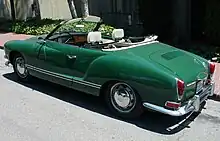
In contrast to the Beetle's machine-welded body with bolt-on fenders, the Karmann Ghia's body panels were butt-welded, hand-shaped, and smoothed with English pewter in a time-consuming process commensurate with higher-end manufacturers, resulting in the Karmann Ghia's higher price.
The Type 14 was marketed as a practical and stylish 2+2 rather than as a true sports car. As they shared engines, the Type 14's engine displacement grew concurrently with the Type 1 (Beetle), ultimately arriving at a displacement of 1584 cc, producing 61 PS (45 kW; 60 hp).
Production doubled soon after the Karmann Ghia's U.S. introduction,[17] becoming the car most imported into the U.S.[17]
In August 1957, Volkswagen introduced a convertible version of the Karmann Ghia. Exterior changes in 1961 included wider and finned front grilles, taller and more rounded rear taillights and headlights relocated to a higher position – with previous models and their lower headlight placement called lowlights. The Italian designer Sergio Sartorelli,[18] designer of Type 34, oversaw the various restylings of Type 14.
In 1970, larger taillights integrated the reversing lights and larger wrap-around turn signals. Still larger and wider taillights increased side visibility. In 1972, large square-section bumpers replaced the smooth round originals, and tail lights were again enlarged. For the USA model only, 1973 modifications mandated by the National Highway Traffic Safety Administration (NHTSA) included energy-absorbing bumpers. A carpeted package shelf replaced the rear seat.
In late 1974 the car was superseded by the Golf-based Scirocco.
| Engine | Displacement | Power | Torque | Wheelbase | L × W × H (m) | Weight | Top speed | 0→100 km/h (0-62 mph) | Fuel cap. |
|---|---|---|---|---|---|---|---|---|---|
| OHV four-stroke air-cooled flat 4 "Volkswagen", single Solex 28 PICT carburettor | 1,192 cc (77 × 64 mm) | 34 PS (25 kW; 34 hp) at 3,600 rpm | 8.4 kg⋅m (82.4 N⋅m; 60.8 lb⋅ft) at 2,000 rpm | 2,400 mm (94.5 in) | 4.14 × 1.63 × 1.33 | 820 kg (1,808 lb) | 120 km/h (75 mph) | ||
| OHV four-stroke air-cooled flat 4 "Volkswagen", Modified with double Solex 32 PBIC carburettor and OKRASA long-stroke crankshaft. |
1,295 cc (77 × 69.5 mm) | 50 PS (37 kW; 49 hp) at 4,200 rpm | 9.6 kg⋅m (94.1 N⋅m; 69.4 lb⋅ft) at 2,800 rpm | 150 km/h (93 mph) |
- Karmann-Ghia taillight comparison
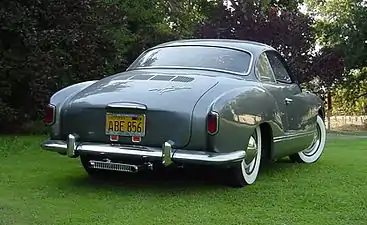 Tail lights (1955–1959)
Tail lights (1955–1959)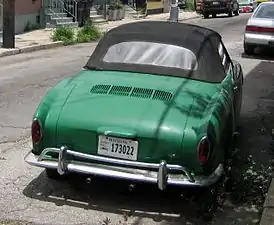 Tail lights (1960–1969)
Tail lights (1960–1969)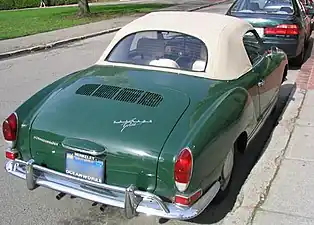 Tail lights US-spec all red (1970–1971)
Tail lights US-spec all red (1970–1971)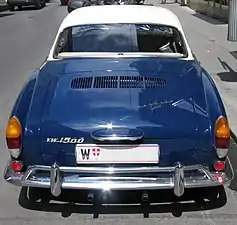 Tail lights Euro-spec red and amber (1970–1971)
Tail lights Euro-spec red and amber (1970–1971)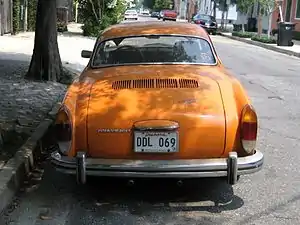 Tail lights (1972–1974)
Tail lights (1972–1974)
Type 34 Karmann Ghia
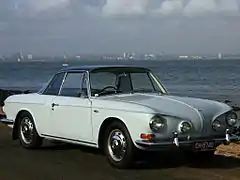


In September 1961, based on the new VW 1500 (Type 3) 'ponton' models introduced that same year, Volkswagen also introduced a new VW 1500 Karmann Ghia model (Type 34),[20] with a new body, designed by Italian engineer Sergio Sartorelli,[18] positioned above the Beetle-based Karmann Ghia 1200 and 1300 models. Featuring more angular 1960s styling, the 1500 offered greater interior and cargo room, in three luggage spaces, than the first generation Karmann Ghia, despite unchanged wheelbase-length. Based on the new 1500's platform, with its new, bigger and more powerful 1500cc engine, the Type 34 was the fastest production Volkswagen of its day.
In 1962, an electrically operated sliding steel sunroof option was added – only the second automobile model in the world to have this option. The Karmann Ghia 1500 further featured round tail lights, built-in fog lights, an electric clock, upper and lower dash pads, door pads, and long padded armrests.
Due to model confusion once the original Type 14 Karmann Ghia was also introduced with the 1500 motor in 1967, the Type 34 was indicated variously as "Der Große Karmann" ("the big Karmann") in Germany, "Razor Edge Ghia" in the United Kingdom, or "European Ghia" (or "Type 3 Ghia" among enthusiasts) in the United States. Today the name Type 34 is recognized as the worldwide naming convention.[20]
Until it was replaced by the VW-Porsche 914, it was the most expensive and luxurious passenger car VW manufactured in the 1960s — at the time costing twice as much as a Beetle in many markets. 42,505 (plus 17 prototype convertibles) were manufactured from 1962–1969.[1]
Although the Type 34 was available in most countries, it was not offered officially in the U.S. – VW's largest and most important export market – another reason for its low sales numbers. Nevertheless, many made their way to the USA (most via Canada), and the USA now has the largest number of known Type 34s left in the world (400 of the total 1,500 to 2,000 or so remaining).[21]
Like the earlier Type 14, the Type 34 was styled by the Italian design studio Ghia. There are some similar styling influences, but the Type 34 Ghia looks very different from the Type 14. The chassis is also a major difference between the cars; the Type 14 shares its chassis with a Beetle (though with a wider floorpan), whereas the Type 34 body is mounted on a Type 3 floorpan and drivetrain (the same as a 1500/1600 Notchback, Fastback or Variant (Squareback)) – all featuring the 1500 'pancake' engine that allowed a front and rear boot. This makes the Type 34 mechanically the same as other Type 3s. However, all bodywork and bumpers, the interior, glass, and most of the lenses are all unique to the Type 34. The car has wider 6.00-15 crossply tyres, until 1968 when they moved to 165R15 Pirelli Cinturato.
The Wilhelm Karmann factory assembly line which assembled the Type 34, since then also produced the VW-Porsche 914 (known as Porsche 914 in the USA), the Type 34's successor as the fastest VW.
Karmann Ghia TC
.jpg.webp)

.jpg.webp)
As an alternative to the Type 34 Karmann-Ghia coupé, which Volkswagen had introduced to Europe in 1961, Volkswagen do Brasil looked to Ghia in Turin for a reworked version of the Type 14 at the end of the 1960s. At the time Ghia employed the now famous Italian designer Giorgetto Giugiaro, who was set to work on the new Brazilian Karmann Ghia. The result was the Volkswagen Karmann Ghia TC (Touring Coupé), internally known as the Type 145, which began production in 1972 and was produced until 1975.[22]
This was a roomy 2+2 coupe with a modern and comfortable interior. Underneath, it still shared components with the Type 14, but the TC used the platform of the VW 1600 Type 3 / Variant models instead of the Beetle's floorpan. The main difference was the engine: the Type 145 TC was fitted with the 1,584 cc flat-four air-cooled boxer unit from the Type 3 instead of the 1200cc units of the Type 14.[23] The car produced 65 hp (48 kW) at 4,600 rpm and had a top speed of 86 mph (138 km/h), compared to the 34 hp (25 kW) and 72 mph (116 km/h) top speed of the Type 14 Karmann Ghia.
18,119 TC models were produced during its production run from 1972 until 1975. It was offered only in South America and was not exported off the continent. There is a prototype that is part of the factory museum collection of Karmann in Osnabrück, Germany.
Subsequent concepts
In 1990, Karmann introduced a Karmann Ghia-inspired concept car – the Karmann Coupe – at the Frankfurt Motor Show,[24] and in April 2013 Karmann Ghia do Brasil launched a competition for Brazilian students to design a modern interpretation of the classic Volkswagen Karmann-Ghia Coupé, possibly leading to the development of a prototype.[25]
References
Notes
- Oswald, Werner (2003). Deutsche Autos 1945–1990, Band 3. Stuttgart: Motorbuch Verlag. pp. 39, 53. ISBN 3-613-02116-1.
- VW
- "Classic Cars: Volkswagen Karmann Ghia". independent.co.uk. 2007-12-04. Archived from the original on December 5, 2007. Retrieved 2008-01-22.
- The VW do Brasil specific TC (Touring Coupé), despite also designed by Ghia, may not have been built by Karmann.
- Malcolm Bobbitt (2004). "Karmann Ghia, p. 7". Veloce Publishing, 2002. ISBN 9781845845513.
- Lee Thomas Hedges. "The Untold Story - VW Karmann Ghia Research & Development". VW Trends Magazine, May 1996.
Carrozzeria Ghia was one of Italy's most prominent auto design firms. The head of Ghia in 1950 was Mario Boano. He was a master craftsman by trade, having worked with coachbuilders in the 1930s and 40s, creating wooden automotive models on contract. After merging with the Carrozzeria Ghia design firm in 1946, he began designing some very original forward thinking cars for firms like Alfa Romeo, Lancia, and Fiat. These cars were designed from 1949 to 1952, and all had similar styling components to what would eventually be the VW Karmann Ghia. Gian Paolo Boano, Mario's son, worked as his assistant from 1950-55 and remembers his father doing design work based on the Beetle chassis during 1950-52. Although his designs were on paper and well detailed his requests for a VW chassis from the VW factory were denied, and no full-size prototypes were ever constructed. "As Carrozzeria Ghia depended on auto design contractors for their livelihood, they were always on the lookout for new clients and new opportunities. In 1951, Luigi Segre was sent to the U.S. to negotiate new business from the American auto makers. He met with the head of Chrysler's show car division, Virgil Exner. Exner had been an automotive design virtuoso, working for Pontiac in the 1930s and Studebaker in the 1940s, and had joined Chrysler in 1950. He was responsible for transforming the entire Chrysler model line in the early 1950s, from squared engineer-inspired boxes to stylish masterpieces. Due to the high cost and time-consuming process of turning auto designs into actual show car prototypes, Exner hired Ghia to build his Chrysler designs in the 1950s. "The most interesting of the cars Ghia built for Exner was the 1953 Chrysler D'elegance. This special bodied car began as a collection of sketches and a plaster scaled model, which was sent to Ghia in Italy in late 1952, completed in early 1953, and returned to Chrysler. Remarkably, the side fender treatment and smooth front end design were strikingly similar to the prototype that Ghia was working on for Karmann in 1953. Since Ghia had both prototype projects being built side-by-side, it is plausible that certain liberties were taken and ideas shared in both Chrysler and Karmann sports car prototypes. Carrozzeria Ghia has denied any link between the 1953 VW Karmann Ghia and the 1953 Chrysler D'elegance. One thing is for certain, however, it is one of the most interesting connections in VW history. "When Luigi Segre returned to the Ghia studios in Italy to break the news that Karmann wanted them to design a prototype sports car for Volkswagen, his excitement and anticipation generated from this opportunity was immense. Since Ghia's owner, Mario Boano, had problems in the past with securing a Beetle chassis from VW, he asked Segre to visit nearby France to get a chassis for this new project. In March 1953, Segre met with the French VW importer, Charles Ladouche, and soon a 1952 Standard Beetle Sedan was ready. Gian Paolo drove to Paris a few weeks later to retrieve the car which was to become the prototype Karmann Ghia Coupe of 1953. Gian Paolo, upon reflection on the secretive project, recalled having problems at the Italian border because he did not have the necessary import papers for this VW. "Now that Ghia had found a chassis, they made the VW sports coupe project their highest priority. With Boano's styling ideas from the past three years, the entire Ghia staff, and huge expectations of success in their minds, Carrozzeria Ghia completed the first prototype in only five months, by September 1953. There have never been any pre-prototype sketches released to the public by Ghia, another interesting fact considering the Chrysler connection.
- Ronnie Schreiber (August 30, 2014). "VW's Karmann Ghia Was a 5/8ths Scale Chrysler". The Truth About Cars.
- "La storia". Karmannghia.it.
- "AUTOMOTIVE DESIGN ORAL HISTORY PROJECT The Reminiscences of Virgil Max Exner, Jr". Automobile in American Life and Society.
[Segre] approached [Chrysler] through C.B. Thomas and engineering to Jim Zeder who was the vice-president of engineering to show what they called the Plymouth 500X. And it was shown to my father [Virgil Exner], and, oh, he thought that their workmanship was wonderful, and just unbelievable compared to these parade cars which had been built by the Chrysler shops at an enormous cost -- two hundred/three hundred thousand dollars. At that time, that was a tremendous amount of money, while Ghia was showing this little Plymouth . It wasn't nearly as big, but it was a totally new body built on a standard chassis, but they were quoting prices for show cars to be built from ten to twenty thousand dollars at that time, and the workmanship was excellent. There was a bit of fear on the part of Chrysler that they would be taking work away from union shops to have these cars built in Italy . But, nevertheless, they signed a contract with Segre to go ahead. Chrysler would design a car, and Ghia would build what became the first true show car that my father was responsible for [from] the new design section at Chrysler.
- Michael Lamm. "SIA Flashback – 1953 Chrysler D'Elegance: Deja Vu All Over Again". Special Interest Autos #136 July/August 1993.
- John F. Katz (September 24, 2006). "1963 Volkswagen Karmann-Ghia: Slower, but Prettier Than Any Porsche". Autoweek.
- "AUTOMOTIVE DESIGN ORAL HISTORY PROJECT The Reminiscences of Virgil Max Exner, Jr". Benson Ford Research Center. The Henry Ford. 1989.
Virgil Exner Jr., [Segre] was a real nice guy -- super guy -- great big fellow. He married quite a wealthy Brazilian gal. They were a neat couple and raised a nice family. They became very good friends with my family. I liked Luigi very much.
- Daniel Strohl (November 10, 2017). "Virgil Exner actually didn't mind that the Karmann Ghia directly copied his 1953 Chrysler D'Elegance". Hemmings Motor News.
- Daryl Scott (January 17, 2016). "Five Things You Might Not Have Known About Virgil Exner". Throwing wrenches.
- "VW launches the Karmann-Ghia in 1955". Autonews.com.
- "The Karmann Story". by Dieter Knust, published by Verlag Meinders & Elstermann GmbH & Co. 1996. Archived from the original on 2002-01-31.
- "Karmann-Ghia Coupe & Convertible, Veloce Publishing".
- "Karmann Ghia Italia – Karmann Ghia Italy" (in Italian). Karmannghia.it. 2008-10-18. Retrieved 2009-10-25.
- Auto Retro. Fontainebleau (FR): Éditions LVA. 2010. p. 132.
- Hedges, Lee Thomas. "Type 3 Ghia (Type 34) History". Retrieved 2007-04-15.
- As per the Type 34 Registry
- Torchinsky, Jason. "This Brazil-Only Ghia May Be The Loveliest Air-Cooled VW Of All". Jalopnik. Retrieved 2018-08-11.
- "Giugiaro's Brazilian Coupe: 1974 VW Karmann Ghia TC in the US". The best vintage and classic cars for sale online | Bring a Trailer. 2017-04-04. Retrieved 2018-08-11.
- "London & Thames Valley VW Club". ltv-vwc.org.uk. Archived from the original on 12 September 2017. Retrieved 2 June 2013.
- "Competition for Brazilian students". cardesignnews.com. Archived from the original on 28 June 2013. Retrieved 2 June 2013.
Bibliography
- Holmes, Mark (2007). Ultimate Convertibles: Roofless Beauty. London: Kandour. pp. 156–157. ISBN 978-1-905741-62-5.
External links
- Karmann Ghia at Curlie
- Tour of the Type 34
- 1974 Karmann Ghia Registry - https://docs.google.com/spreadsheets/d/1O4MQepBrAnwCKn9EXzSVPUmVA_oUOJU-WrmFUxON-qQ/edit#gid=0
- TheSamba.com - great spot for KG info for hobbyists
